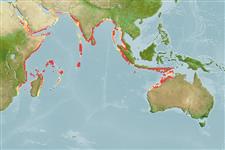رده بندی / Names
اسامي عام | مترادف | Catalog of Fishes(جنس, گونه ها) | ITIS | CoL | WoRMS | Cloffa
>
Eupercaria/misc (Various families in series Eupercaria) >
Lutjanidae (Snappers) > Lutjaninae
Etymology: Lutjanus: Malay, ikan lutjan, name of a fish; indicus: Named for its Indian Ocean distribution..
Environment: milieu / climate zone / depth range / distribution range
بوم شناسي
دريايي; آب شيرين; لب شور وابسته به آب سنگ; تغييرات عمق 5 - 50 m (Ref. 93093), usually 5 - 15 m (Ref. 93093). Tropical
Indian Ocean: northern continental margin of the Indian Ocean including western Thailand, Myanmar, Andaman Islands, Sri Lanka, India, Gulf of Oman and Arabian Gulf. Western Indian Ocean distribution of L. russellii mentioned in Allen & Talbot, 1985 (Ref. 469) is provisionally referred to as L. indicus; population needs to be reassessed..
Size / Weight / سن
Maturity: Lm ? range ? - ? cm
Max length : 22.6 cm SL جنس نر / بدون خواص جنسي; (Ref. 93093)
توصيف مختصر
ريخت شناسي | ريخت ستجي بوسيله انداره گيري
خارهاي باله پشتي (کل): 10; شعاع نرم باله پشتي (کل): 13-14; خارهاي باله مخرجي 3; شعاع نرم باله مخرجي: 8. This species is distinguished by the following set of characters: D X,13-14 (usually 14); total gill rakers 12-14; body depth 2.5-2.9 in SL; eye 4.2-4.6 in HL; interorbital 5.9-7.0 in HL; the scale rows above the lateral line rise obliquely toward dorsal profile; predorsal scales extending forward nearly to level of rear part of orbit; weakly developed preopercular notch and interopercular knob; upper surface of tongue with central patch of fine granular teeth; vomer with diamond-shaped to narrowly crescent-shaped patch of granular teeth with medial posterior extension; truncate caudal fin; in life it is overall pale grey, grading to silvery white on cheek, opercle, and lower side of body with series of seven dark brown to yellow stripes on posterior head and side, prominent black spot, about 1.2-1.5 size of eye, on posterior back below base of first 6-7 soft dorsal rays, its lowermost part occupying about one scale row below lateral line (Ref. 93093).
This species was observed in coral-reef habitat; generally encountered solitary or in small groups in about 5-15 m depth. It is also taken by trawlers in deeper water (to at least 50 m) and usually appears in fish markets. Few information on juvenile habitat, but suspected to be similar to L. russellii where young are found in brackish mangrove estuaries and lower reaches of freshwater streams (Ref. 93093).
Life cycle and mating behavior
بلوغ | تولید مثل | تخم ریزی | تخم ها | Fecundity | توزاد ( لارو)
Allen, G.R., W.T. White and M.V. Erdmann, 2013. Two new species of snappers (Pisces: Lutjanidae: Lutjanus) from the Indo-West Pacific. J. Ocean Sci. Found. 6:33-51. (Ref. 93093)
وضعيت در فهرست قرمز IUCN (Ref. 130435)
خطر برای انسان ها
Harmless
استفاده انسانی
اطلاعات بيشتر
اسامي عاممترادفسوخت و سازشکارچیانسم شناسي بوم زيستيتولید مثلبلوغتخم ریزیSpawning aggregationFecundityتخم هانمو تخم
Age/Sizeرشدطول - وزنطول - طولنوسانات طولیريخت ستجي بوسيله انداره گيريريخت شناسيتوزاد ( لارو)پويايي لارويبازسازیفراوانيBRUVS
مراجعآبزي پرورينمايه آبزي پرورينژادهاژنتيكElectrophoresesوارثبيماري هافرآوریNutrientsMass conversion
همكارانعکس هاStamps, Coins Misc.صداهاسيگواتراسرعتنوع شناگریمنطقه آبششيOtolithsمغزهابینایی
ابزارها
گزارش های ويژه
بارگيری XML
منابع اينترنتي
Estimates based on models
Preferred temperature (Ref.
123201): 26.8 - 29.3, mean 28.3 °C (based on 684 cells).
Phylogenetic diversity index (Ref.
82804): PD
50 = 0.5000 [Uniqueness, from 0.5 = low to 2.0 = high].
Bayesian length-weight: a=0.01230 (0.00706 - 0.02143), b=2.94 (2.80 - 3.08), in cm total length, based on LWR estimates for this species & Genus-body shape (Ref.
93245).
Trophic level (Ref.
69278): 3.8 ±0.6 se; based on size and trophs of closest relatives
جهندگی (Ref.
120179): زياد, كمينه زمان لازم براي دو برابر شدن جمعيت ، كمتر از 15 ماه (Preliminary K or Fecundity.).
Fishing Vulnerability (Ref.
59153): Low vulnerability (18 of 100).
